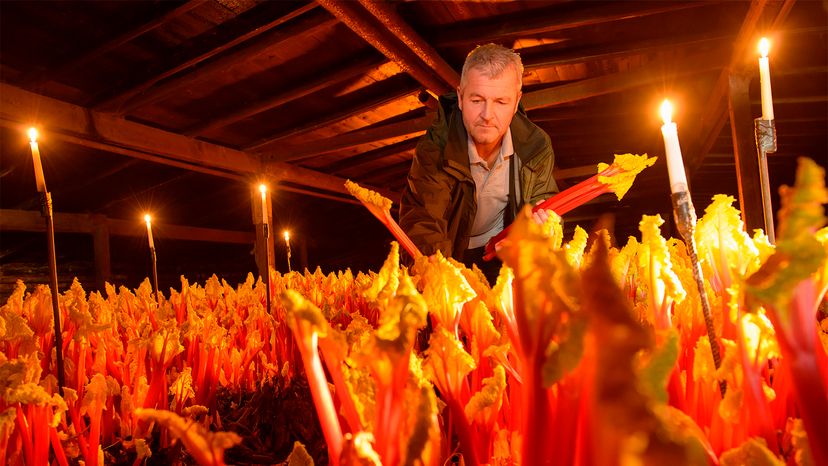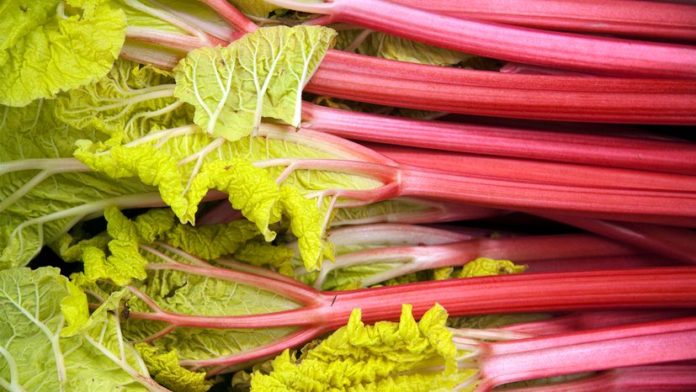 “Fresh rhubarb (Rheum rhaponticum) has bright red stems that are totally edible — just stay away from eating the leaves. Lisa Stokes/Getty Images
“Fresh rhubarb (Rheum rhaponticum) has bright red stems that are totally edible — just stay away from eating the leaves. Lisa Stokes/Getty Images
Is it a fruit? Is it a vegetable? Most people don’t really seem to know, but they know one thing for sure: They’ve never tasted anything quite like it. You’d be forgiven for thinking that we’re referring to a tomato, but there’s actually another red-hued plant on our mind: rhubarb.
What Is Rhubarb?
Rhubarb is a plant known for its frilly green leaves (more on those later) and its sour — and vividly red — stalks that resemble celery in shape and texture. Although rhubarb originated in Asia, it is now grown across Europe and North America, most famously in the Rhubarb Triangle, which is the area between Wakefield, Morley and Rothwell in the U.K.
In the United States, the Pacific Northwest is perhaps the most common area for growing rhubarb, as the plant thrives in that climate. Tim Richter is a fourth-generation farmer of rhubarb in Puyallup, Washington, and the owner of EG Richter Family Farm.
Richter’s great-grandfather went west from Minnesota during the Gold Rush, but he missed the boat on that opportunity and instead started a family farm growing rhubarb and other crops in the late 1800s. The farm has been passed down through the generations, and Richter’s son now also helps run the farm.
"There’s nowhere in the world that is better for growing rhubarb than the Puyallup valley. They kind of like the moist, mild climate, and that’s what you’ve got in Washington, specifically western Washington," says Richter. "When you get too much sun and too much heat, the rhubarb can grow, but what tends to happen … it loses the color. The stalks start to turn quite green."
Field Rhubarb vs. Hothouse Rhubarb
Not all rhubarb tastes or looks the same. Two different varieties of rhubarb compete on the market: field rhubarb and forced (also known as hothouse) rhubarb.
As the name implies, field rhubarb comes straight from the field. As field rhubarb becomes exposed to outdoor light, it can have a greener tinge and a slightly stringier texture when you crack open the stalk, according to Richter.
Hothouse, on the other hand, requires a more deliberate, careful growing process, which entails depriving the rhubarb of light inside a hothouse in order to better draw out its natural red hue. The only time that the rhubarb becomes exposed to indoor lighting is during the harvesting process. Richter explains the careful work that goes into raising hothouse rhubarb:
You grow this plant in the field for two years until [the root ball] becomes a pretty-good-sized ball. About a hundred-pound ball. Then we file those out of the soil in December once the plant’s gone dormant. And then we bring them into these buildings. Stack them in these aisles. Close the doors and turn on the heat with a little water, and it starts shooting up the stalk in search of light. And then we come along and pull it off.
Richter explains that due to the lack of light exposure, the hothouse rhubarb leaves often turn "bright yellow" and the stalks turn into a "brilliant red" color. These unusual colors and the delicate growing process means that hothouse commands a premium price compared to field rhubarb.
But as for which one tastes better? Richter is agnostic on that front.
"You put two stalks side by side, one being hothouse, one being field, you would probably taste that difference. I don’t want to say one’s better than the other. They’re different."
Outside the U.S., Yorkshire growers in the U.K. receive worldwide acclaim for their hothouse, or forced, rhubarb. They’re especially known for the traditional practice of harvesting rhubarb by candlelight to keep the stalks tender.
 “A farmer harvesting rhubarb in a candlelit barn.Monty Rakusen/Getty Images
“A farmer harvesting rhubarb in a candlelit barn.Monty Rakusen/Getty Images
The Rise and Fall of Rhubarb
The popularity of American-grown rhubarb has fallen in recent decades since its heyday in the 1960s and ’70s, according to Richter. With so much international produce coming in from across the world, it can be hard for the hearty red plant to compete in the global market. Plus, most recipes require the rhubarb to be cooked, which can make it less appealing than ready-to-eat produce.
"When my great-grandfather was doing it, and my grandfather, there wasn’t all the shipping products coming from South America and all over the world. Rhubarb was kind of the first group on the market, so to speak. It was a big thing," says Richter.
Richter says that farmers are growing less rhubarb in the U.S. as the supply adjusts to the drop in consumer demand.
But there are still plenty of rhubarb enthusiasts out there, as seen in the plethora of rhubarb-centric festivals from Wakefield in the U.K. to Pennsylvania Dutch Country to Lanesboro (also known as the Rhubarb Capital of Minnesota).
And if you want to find rhubarb, Richter says that many of the major chain grocery stores in the U.S., like Kroger and Safeway, readily carry it.
So, Is Rhubarb a Fruit or a Vegetable?
Due to its frequent use in sweet treats, it’s no surprise that home cooks might think that rhubarb is a fruit. And in 1947, a U.S. Customs court in Buffalo, New York, even deemed rhubarb to be a fruit, because cooks primarily use it that way. By legally classifying rhubarb as a fruit, the court made it so that rhubarb could be taxed with smaller import fees — even though rhubarb wasn’t really a fruit.
Wait, what? Yes, despite the legal classification, rhubarb is actually a vegetable in botanical terms. The rhubarb’s stalk can be defined as a petiole, which connects a leaf to a stem. In botanical terms, the edible petiole officially marks rhubarb as a vegetable.
But if you want to go on calling it a fruit, Richter certainly won’t blame you. "For the person cooking it up, I would say rhubarb is a fruit."
Is Rhubarb Poisonous?
Typically, you would only eat the stalk of a rhubarb plant, which is safe to eat both raw and uncooked, according to Richter. The stalk contains no poisons, and you will normally not get sick eating it, though you’ll likely want to sweeten or cook the stalk before eating it to make it more palatable.
Rhubarb leaves, however, are a different story, and should NOT be consumed, unless you are looking for a nasty bout of food poisoning. Rhubarb leaves contain a lethal toxin known as oxalic acid. Although other plants contain oxalic acid in small amounts, rhubarb leaves contain a more potent dose of it, which makes them more toxic to humans.
True, you’re unlikely to eat a lethal dose of oxalic acid in one sitting of crazy rhubarb leaf consumption, but the risk is definitely still there. You may also suffer from nausea or vomiting even when consuming lower doses of oxalic acid.
So, to be on the safe side, do not consume rhubarb leaves. But rhubarb stalks are perfectly fine to eat.
How Do You Cook Rhubarb?
There are endless ways that you can prepare rhubarb. The most common would be in a pie. Rhubarb is so closely associated with pie-making that it’s earned a common nickname, according to Richter: the pie plant. Any rhubarb cookbook worth its salt will feature strawberry rhubarb pie, pairing the sweet flavor of the strawberry with the slightly tart flavor of the rhubarb. It’s also common to combine apples with rhubarbs.
But what if you’re hankering for some other creative ways to make use of your new favorite vegetable? Richter suggests a rhubarb crisp, much like an apple crisp. Or, you can try one of Richter’s favorite methods of preparing rhubarb, which involves cooking down rhubarb in a pan, combining it with sugar to taste, and cooling it down before spooning it over vanilla ice cream.
Other popular sweet rhubarb recipes include rhubarb cobbler, rhubarb bread, rhubarb cake, and rhubarb cookies. For savory rhubarb meals, you can try baked Brie with rhubarb chutney, rhubarb chicken, rhubarb fish and rhubarb soup. And if you’re looking to test out your brewing chops, you can even make a fine rhubarb mead.
But if you’re not up for cooking, you can always grab a raw rhubarb stalk and dip it in sugar for a crunchy snack, according to Richter, who enjoyed this treat as a child.
Health Benefits of Rhubarb
While we may argue over whether rhubarb is a fruit or a vegetable today, the ancient Chinese considered rhubarb a practical purgative medicine; Marco Polo reportedly stumbled across rhubarb on his travels to China in 1271. The Romans commonly used rhubarb as bowel-cleansing medicine as well.
Trade brought rhubarb to Europe, and the plant became sought after as a medicinal plant in Britain. In 1771, Benjamin Franklin introduced Chinese rhubarb to his friend, John Bartram, who worked as a botanist for the king of England in the American colonies. It wasn’t until the early 19th century that rhubarb shifted from being primarily a medicinal plant to a dessert plant used in pies in North America and the United Kingdom.
Rhubarb’s medicinal properties have long been known in America, and Richter says that rhubarb has a reputation for aiding in digestion, though it’s unclear to what extent science supports these claims.
Today, scientists study rhubarb for its numerous purported health benefits, including treatment for heatstroke, kidney failure, wound healing and cancer and for its anti-inflammatory and anti-oxidant properties.
Now That’s Cool
Rhubarb has even been studied as an alternative to antibiotics, which are often misused in the livestock industry, raising consumer safety concerns. Researchers tested out this hypothesis in one fun study, published in January 2018 in ACS Publications, in which goat kids were fed a steady diet of supplemental rhubarb.








































